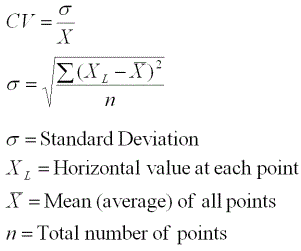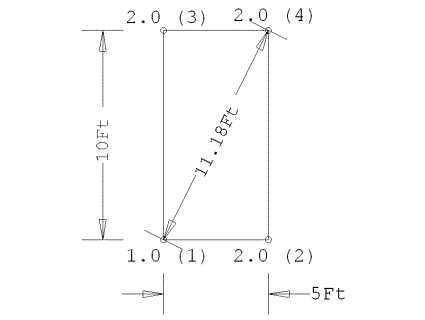
Average
This metric averages all of the values (that have not been removed) at each point. The average is obtained by summing all of the calculated values in the grid and dividing by the total number of points within the same grid.
Maximum-Minimum values
This metric looks at each point in the grid and finds the maximum and minimum value.
Average-Minimum Ratio
The Average-Minimum ratio divides the calculated average by the calculated minimum value. In certain parts of the world, the inverse ratio (Minimum-Average) is used. See the Tools-System Settings for more information.
Maximum-Minimum Ratio
The Maximum-Minimum ratio divides the calculated maximum value by the calculated minimum value. The opposite uniformity ratio (Minimum-Maximum) is used in certain parts of the world. See the Tools-System Settings for more information.
Maximum-Average Ratio
The Maximum-Average ratio divides the calculated maximum value by the calculated average value.
Coefficient of Variation (CV) is a metric used to measure uniformity in sports lighting. CV is defined as the ratio of the standard deviation of all values to the mean (average) value. Please see IES RP-6-88 for various recommendations on acceptable limits of CV.

Uniformity Gradient (UG) is typically used to measure uniformity in sports lighting applications, however it can be used to measure the rate of change for any calculated metric. This metric measures how fast the values falls off between measuring points. Specifically, the UG measures the rate of change of values between adjacent measuring points, side to side, up, down or diagonal. The rate of change is weighted by the distance between the points (the greater the distance, the less rate of change).The UG value is expressed as a ratio of values.
The reported UG value indicates the highest ratio or greatest rate of change.
Example:

UG (Pt. 1 => Pt. 2) = 2/1 = 2.0 (reference distance; distance represent unit vector)
UG (Pt. 1 => Pt. 3) = 2/1* (5/10) = 1.0 (value weighted due to greater distance than Pt. 1 => Pt.2)
UG (Pt. 1 => Pt. 4) = 2/1* (5/11.18) = 0.89 (value weighted due to greater distance than Pt. 1 => Pt. 2)
Reported UG = 2.0
Please see IES RP-6-01 for various recommendations on acceptable limits of UG for sports lighting.
Luminance designation (labeling)
Whenever luminance is calculated, the following designations are used to define which luminance metric is being referenced or displayed.
- L_Roadway (Roadway Luminance)
- L_Veiling (Veiling Luminance)
- L_Diffuse (Diffuse Luminance)